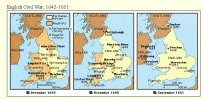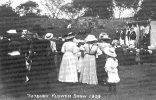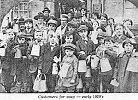12th to 20th century
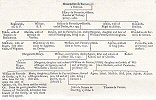 From
this point onwards the documents blossom - they are mainly lists of people
who pay rent and other documents relating to money, or reports of trials
and other legal documents.
From
this point onwards the documents blossom - they are mainly lists of people
who pay rent and other documents relating to money, or reports of trials
and other legal documents.
The best way of tackling the next 200 years is to work through the family tree of the Ferrers family and point out the interesting bits:
| Lords of the Manor |
|
|---|---|
| Henry |
Great pals with King William l, built a castle from which he administers his enormous estate. He also built the church, most of which we see now as he built it. |
| Robert l d1139 |
Henry's third son was Robert. He founded the Priory and was elevated to the peerage as Earl of Derby. |
| William l d1139 |
Robert's son. He was created Earl of Tutbury but it didn't last long because he was murdered in London in the same year. |
| Robert ll d1141 |
William's brother. He styled himself Earl de Ferrers the younger and was also Earl of Nottingham |
| William ll d1190 |
Robert's son. This is now the time of King Henry ll and William supported the King's son, Richard the Lionheart and Geoffrey, against the King. The King got cross with this and led an army from Newcastle under Lyme in 1174 and sacked the castle and the town. William regained favour when Richard came to the throne and they remained great pals. William accompanied Richard on a Crusade and died there in 1190. |
| William lll d1247 |
William's son. He was friendly with King John and who visited Tutbury in 1201, resurrecting the title Earl of Derby to William. Just as the Monarch dubs a Knight with a sword, an Earl is given a belt, which the Monarch puts round the new Earl's waist. This tradition dates from this time and William was the first person to be ceremoniously 'done' in this way. William invited King John in 1201 and 1204. |
| William lV d1254 |
|
| Robert lll d1278 |
King Henry lll was in Tutbury in 1251 and his Queen, Eleanor stayed while the King went to fight the Welsh. The Queen preferred Tutbury to Nottingham because she could not endure the 'smoke of the sea-coal'. Robert married the King's niece, Mary – very cosy. The Ferrers are an important, influential, rich family who have Royalty as relatives and houseguests. But now Robert came unstuck. He rebelled against the King in 1264 and captured Prince Edward (later to become Edward l). Edward escaped and retaliated by attacking and demolishing the castle. Robert was captured and charged with treason, pardoned on payment of a fine. He rebelled again, was beaten again and had all his lands confiscated in 1266. |
 The
King gave the Ferrers lands to his own third son, Edmund 'Crouchback' who
was created Earl of Lancaster the following year. That is how Tutbury came
into the hands of the Earls and later the Dukes of Lancaster, and ultimately
the Monarch who absorbed the Duchy a bit later.
The
King gave the Ferrers lands to his own third son, Edmund 'Crouchback' who
was created Earl of Lancaster the following year. That is how Tutbury came
into the hands of the Earls and later the Dukes of Lancaster, and ultimately
the Monarch who absorbed the Duchy a bit later.
Our present Queen is still the Duke of Lancaster and hence Lord of the Manor - she owns much of the land hereabouts, including the castle and several farms. There is still a Baron Ferrers who is now Earl of Tamworth.
The Houses of Anjou, Lancaster and York
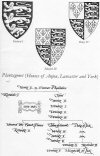 The
next part of the history is connected with the Dukes of Lancaster. We've
just mentioned Edmund Crouchback, now we'll come to his son Thomas. He repaired
the damage done to the castle 30 years earlier and made Tutbury his principal
residence.
The
next part of the history is connected with the Dukes of Lancaster. We've
just mentioned Edmund Crouchback, now we'll come to his son Thomas. He repaired
the damage done to the castle 30 years earlier and made Tutbury his principal
residence.
He was a cousin of King Edward ll (who was one of the three homosexual Kings of England and was later murdered) but no friend and he was the leading light in the Baron's war.
To teach him a lesson, the King mustered an army and marched towards Tutbury from Coventry (along the Ashby Road). Thomas got wind of this and defended the castle with 30,000 men. Thomas hoped to stop the King at Burton Bridge and got there first, fortified it and held the King's army at bay for a while.
This was the only crossing point over the Trent for miles in either direction so the King was in a quandary. But then a spy from Burton Abbey, who Thomas had upset, told the King about a little known ford at Walton where the little bailey bridge now is.
On 10 March 1322, the King left a decoy force at the bridge, took the bulk of his army up river, across the ford, back to Burton and attacked Thomas' right flank by surprise. Thomas was soundly thrashed and retreated to Tutbury Castle, leaving Burton in flames.
He got to Tutbury expecting to find reinforcements of Scottish (Robert the Bruce) and Welsh mercenaries, but they never turned up. He gathered up what valuables he could and ran away across the River Dove. (See Silver Coins).
Soon, the King reached Tutbury and demolished the castle again. Thomas was eventually captured and executed. The estate was handed to his brother Henry. His son was promoted from Earl to Duke of Lancaster. His daughter Blanche then inherited the estate and on her marriage the title and property went to her husband - John of Gaunt.
 John
of Gaunt was a very influential and powerful bloke. He was the son of King
Edward lll and father of the future Henry lV, who spent much of his childhood
at Tutbury. His descendents were the Royal House of Lancaster and the Tudors.
John
of Gaunt was a very influential and powerful bloke. He was the son of King
Edward lll and father of the future Henry lV, who spent much of his childhood
at Tutbury. His descendents were the Royal House of Lancaster and the Tudors.
Tutbury Castle had been derelict since 1322 so John had to rebuild it and made it his principal residence. Blanche lived here while John was away fighting the French but the poor girl died of plague at the age of 29.
Three years on, John married again, this time to Constantia, daughter of the King of Castille and Leon (Spain). John adopted the title King of Castille, set up a court in Tutbury and lived in regal splendour. This was Tutbury's Golden Age. One of Constantia's Ladies in Waiting was Phillippa, wife of Geoffrey Chaucer and one of his lengthy poems is dedicated to Constantia. Phillipa's sister, Catherine Swynford was governess to the Gaunt children, John's mistress and eventually his wife. Constantia laid out the gardens - a field nearby called the 'Queen's Garden' after her - as orchards and vineyards.
The market now began to flourish and Tutbury was nationally famous as a market town. Its activities were greatly influenced by the comings and goings at the Castle. It was held every Tuesday in Market Street - now High St - and culminated once a year with Tutbury Fair. This was held during the week of 15th August, which was the anniversary of the founding of the church. It was called Tutbury Day. The fair was very grand with many market traders and the shops were prohibited from opening all week. There was plenty of entertainment, jugglers, jesters, minstrels, side shows, bear baiting, bull-running and much merry-making, including much quaffing of ale.
The minstrels were very popular all over the country and they decided to form the Minstrels Court and held their annual general meeting (to fix rules and regulations) at Tutbury Fair - a sort of medieval trades union conference. One man was elected King of the Minstrels and he reigned for a year. The court lasted until Stuart times but the King of the Minstrels persisted as a tradition for longer. There is a memorial in Tatenhill Church, dated 1739, to Henry Coxon, 'last of the Tutbury Minstrels'.
I ought to say something about Bull-running. Each year the Prior of Tutbury had to provide a bull - it was tormented and let loose from a site next to the Dog and Partridge. If the residents could catch it before it reached the River Dove they could keep it, otherwise it was the Prior's. The custom persisted until 1778 when a man died from a fractured skull and it was stopped by order of King George lll.
Robin Hood is said to have visited Tutbury Fair and a lengthy ballad of the time tells the story of how he married a lady called Clorinda ('Queen of the Shepherds') in Tutbury Church on 15th August. It could be that Robin was here to buy a quiver for his arrows - a medieval order form, specifies 'a quiver of Tutbury make' suggests that the town was renowned for the manufacture of such items. We've already mentioned Geoffrey Chaucer and a ballad about Robin Hood and there's another literary reference - in the 12th century poem 'Hereward the Wake' - the hero's murderer sets out from Tutbury.
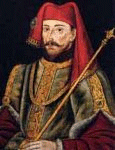 John
of Gaunt died in 1399, leaving his eldest son Henry 'Bolingbroke' (referred
to frequently by Shakespeare) inherited the estate. In the same year he
deposed his cousin Richard ll to become King Henry lV (first of the House
of Lancaster) and so the Duchy, including Tutbury, came to the Monarch.
So a new chapter in Tutbury's history opens. The Lords of the Manor are
now the King's and Queen's of England and naturally, as Tutbury is no longer
their principal residence, things tend to quieten down a bit, although there
are records of several visits.
John
of Gaunt died in 1399, leaving his eldest son Henry 'Bolingbroke' (referred
to frequently by Shakespeare) inherited the estate. In the same year he
deposed his cousin Richard ll to become King Henry lV (first of the House
of Lancaster) and so the Duchy, including Tutbury, came to the Monarch.
So a new chapter in Tutbury's history opens. The Lords of the Manor are
now the King's and Queen's of England and naturally, as Tutbury is no longer
their principal residence, things tend to quieten down a bit, although there
are records of several visits.
Henry lV came back to his home on several occasions, notably in 1404 including one in August for the Fair.
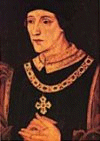 Henry
Vl came in 1434 and 1440.
Henry
Vl came in 1434 and 1440.
Henry Vlll ascended the throne in 1509 but there is no record of a visit, which is surprising, given his love of hunting, for which the Needwood Forest was very suitable. He made his mark though, because he quarrelled with the Pope, broke from the Roman Catholic Church and dissolved all the monasteries, including Tutbury Priory. The buildings were demolished but the Church was left standing because it was also the Parish Church where the peasants worshipped.
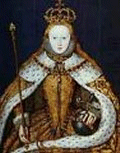 Elizabeth
l visited Tutbury and evidently made a point of sampling the Burton beer,
which was gaining a reputation. The next event in Elizabeth's reign, as
far as Tutbury was concerned, was the imprisonment of Mary Queen of Scots,
who of all these royal visitors is probably the one most remembered.
Elizabeth
l visited Tutbury and evidently made a point of sampling the Burton beer,
which was gaining a reputation. The next event in Elizabeth's reign, as
far as Tutbury was concerned, was the imprisonment of Mary Queen of Scots,
who of all these royal visitors is probably the one most remembered.
Mary was born in Scotland as a Catholic and within four days of her birth, she inherited the throne when her father, James V, died. Remember that Scotland was a separate Kingdom at the time. At the age of five, she was betrothed to the heir to the throne of France and at fifteen; she married him and became Queen of France as well. A year later, Mary's cousin Elizabeth came to the throne of England but the Catholics in the country regarded the Protestant Elizabeth as illegitimate and recognized Mary as Queen of England, She was heir, as Elizabeth had no children.
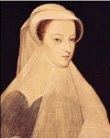 The
King of France then died, so at the age of eighteen she was a widow, Queen
of Scotland, Queen of France and heir to England. Husband number two was
Lord Darnley and this strengthened her claim. Then she got fed up with him
and had her eye on the Earl of Bothwell. A mysterious gunpowder explosion
destroyed Darnley's house and his body was found the next day - he had been
strangled trying to escape. Soon afterwards, she married Bothwell - suspicious?
The
King of France then died, so at the age of eighteen she was a widow, Queen
of Scotland, Queen of France and heir to England. Husband number two was
Lord Darnley and this strengthened her claim. Then she got fed up with him
and had her eye on the Earl of Bothwell. A mysterious gunpowder explosion
destroyed Darnley's house and his body was found the next day - he had been
strangled trying to escape. Soon afterwards, she married Bothwell - suspicious?
The Scots had had enough of all this - there was not enough proof that the two of them had murdered Darney but there was a civil war, she was forced to abdicate and fled to England for Elizabeth's protection. Problem for Elizabeth - Mary is an influential Catholic and a threat to the English throne, but nevertheless, she is Elizabeth's cousin, of royal blood and had thrown herself on Elizabeth's mercy. Elizabeth put Mary under a reasonably tolerant house arrest but kept moving her around to diminish the possibility of escape plots. That is how she came to be imprisoned in Tutbury Castle. She was here in 1568 with a retinue of 50 people and she complained of the smell and unsanitary conditions. She was back in 1572, 1578, 1581 and 1585. She was held under these conditions for nineteen years in all.
In 1586, a young Catholic called Anthony Babbington devised a plot to murder Elizabeth and set Mary on the Throne of England. He communicated with Mary by hiding letters in barrels of beer from Burton (7d a gallon at this time!) but the brewer was a double agent and gave the letters to Elizabeth's chief minister before passing them on. Mary was moved to Chartley Castle (not far away and the brewer continued to supply beer at 10d a gallon) but in September 1586 she was arrested, charged with treason and executed the following February at the age of 44. Mary was evidently magnificently defiant, but calm on the scaffold. It took two blows of the axe to chop off her head.
 Her
son, James Vl of Scotland became James l of England as well and was here
in 1619, 1621 and 1624, each time in August for the Fair and hunting.
Her
son, James Vl of Scotland became James l of England as well and was here
in 1619, 1621 and 1624, each time in August for the Fair and hunting.
We are now in the Stuart Dynasty and King Charles l was here in 1634, 1635 and in1636 when the Fair was postponed due to danger of the plague.
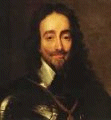 Now
we come to the English Civil War - Tutbury had a bit of a problem here –
the garrison at the castle was on the side of King Charles l, and he mustered
his men there before the Battle of Edgehill.
Now
we come to the English Civil War - Tutbury had a bit of a problem here –
the garrison at the castle was on the side of King Charles l, and he mustered
his men there before the Battle of Edgehill.
The town was on the Roundhead’s side and in 1643 the castle was besieged, although the siege was abandoned. The King was back in 1645 just before the Battle of Nazeby, where he was firmly beaten, and again just afterwards. His last visit was on 12th August of that year, on his way from Lichfield to Ashby.
 By
1646, Tutbury Castle was one of the last Royalist strongholds of Charles
I and it was besieged again by Oliver Cromwell, for three weeks during March
and April after which it surrendered.
By
1646, Tutbury Castle was one of the last Royalist strongholds of Charles
I and it was besieged again by Oliver Cromwell, for three weeks during March
and April after which it surrendered.
A year later, Parliament ordered that it be rendered incapable of military use (slighted). So the Castle is in ruins because, like so many others, Cromwell had it pulled down.
This was the beginning of the end for Tutbury - the life of the town had revolved around the Castle and the Priory and both were now gone. The town went into a slow decline, the market and Fair were discontinued, the tradesmen left and Tutbury settled down to the small town life that we know today.
Flower Show 1909 and Customers for Soup 1920s



